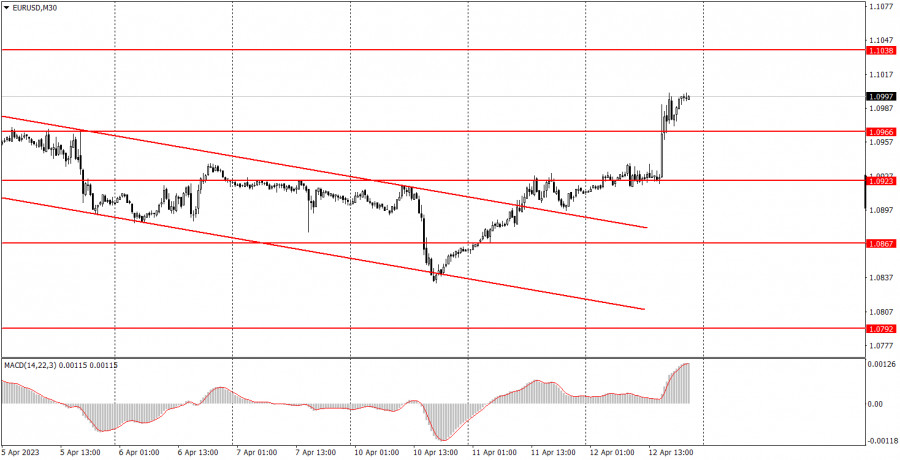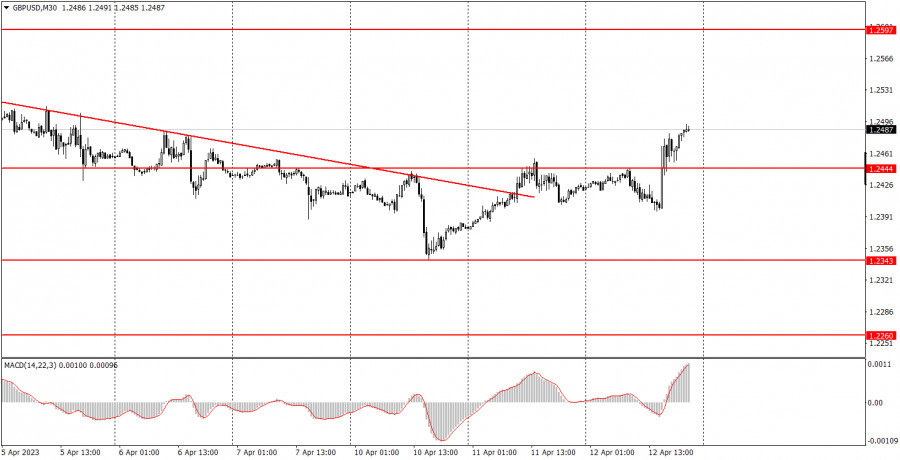

On Thursday, there will be many macroeconomic events worldwide, but most of them aren't that important. For example, in the morning, Germany will publish its inflation report for March. It seems like an important report, but this is only the second, final value, so it is unlikely to differ from the first one and will probably not provoke any market reaction. A little later, the UK will release reports on industrial production and GDP. Industrial production has not been an important report for a long time, and the reaction may be minimal, just 10-20 pips. Speaking of GDP, even the quarterly report does not always provoke traders into being active, and it will be a monthly report for February. This means that the chances of seeing a market reaction are even smaller.
The eurozone will release its industrial production report, and the preview is exactly the same as for the British one. Meanwhile, the US will publish its Producer Price Index, which some experts consider as the main indicator after inflation in determining price changes. I personally don't think so, since the market hardly reacts to this data. Not to mention the jobless claims report. Take note that if the results of these data significantly differ from forecasts, then a strong reaction may follow. However, significant discrepancies from the forecast are extremely rare.
Analysis of fundamental events:
Among the events, I am going to highlight the speech of Bank of England's Chief Economist, Huwe Pill. BoE Governor Andrew Bailey did not share any new or important information, so we will have to carefully listen to Pill and hope that at least he will guide the market on interest rates and prospects. Hawkish rhetoric from Pill may provoke an even greater growth in the pound, while dovish rhetoric may lead to its decline. Additionally, late at night, there will be a speech by Bundesbank President Joachim Nagel, who may touch on the topic of the European Central Bank's key interest rate.
General conclusions:Thursday promises to be quite an interesting day. If the events and reports mentioned above do not present any blatant surprises, trade will probably be sluggish. The euro and the pound will try to grow, but remember that they can't rise every single day. However, we have formed uptrends for both currency pairs, and you can trade on the 5-minute chart regardless of the trend.
Basic rules of the trading system:1) The strength of the signal is determined by the time it took the signal to form (a rebound or a breakout of the level). The quicker it is formed, the stronger the signal is.
2) If two or more positions were opened near a certain level based on a false signal (which did not trigger a Take Profit or test the nearest target level), then all subsequent signals at this level should be ignored.
3) When trading flat, a pair can form multiple false signals or not form them at all. In any case, it is better to stop trading at the first sign of a flat movement.
4) Trades should be opened in the period between the start of the European session and the middle of the US trading hours when all positions must be closed manually.
5) You can trade using signals from the MACD indicator on the 30-minute time frame only amid strong volatility and a clear trend that should be confirmed by a trendline or a trend channel.
6) If two levels are located too close to each other (from 5 to 15 pips), they should be considered support and resistance levels.
On the chart:Support and Resistance levels are the levels that serve as targets when buying or selling the pair. You can place Take Profit near these levels.
Red lines are channels or trend lines that display the current trend and show in which direction it is better to trade now.
The MACD indicator (14, 22, and 3) consists of a histogram and a signal line. When they cross, this is a signal to enter the market. It is recommended to use this indicator in combination with trend patterns (channels and trendlines).
Important announcements and economic reports that can be found on the economic calendar can seriously influence the trajectory of a currency pair. Therefore, at the time of their release, we recommend trading as carefully as possible or exiting the market in order to avoid sharp price fluctuations.
Beginners on Forex should remember that not every single trade has to be profitable. The development of a clear strategy and money management is the key to success in trading over a long period of time.